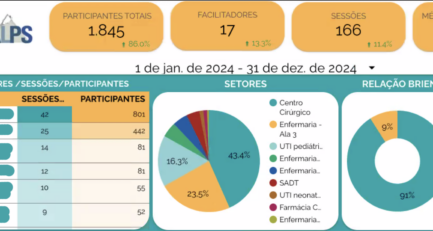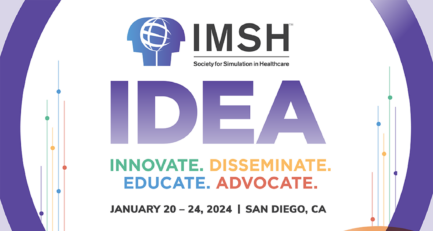
For the 25th year in a row, students from the Harvard-MIT Program in Health Sciences and Technology (HST) visited the Center for Medical Simulation (CMS) to gain hands-on experience in clinical care. The HST program is an innovative partnership between the Massachusetts Institute of Technology (MIT), Harvard Medical School, Harvard University and Boston area teaching hospitals. Lead by Harvard and MIT faculty, students from engineering, science, and medical programs come together to work on solving healthcare issues.
To aid the collaboration, CMS hosts the HST program annually and provides the group access to its facility and simulation tools. This year, 48 students visited CMS and worked on ways to improve patient safety, delivery of care, and medical technology. The group was led by:
• Jose Gabriel Venegas, PhD: Associate Professor in Anesthesia (Bioengineering) Massachusetts General Hospital and Harvard Medical School, 1983 graduate from the HST MEMP program and current faculty at HST
• Paul Dieffenbach, MD: Instructor in Medicine at Harvard Medical School, pulmonologist affiliated with the Division of Pulmonary and Critical Care at the Brigham and Women’s Hospital
• Tilo Winkler, PhD: Assistant Professor in Anesthesia (Bioengineering) at Harvard Medical School and researcher at Massachusetts General Hospital
• Charles Hardin MD, PhD: HST100 Course Director, Assistant Professor in Medicine at Harvard Medical School, pulmonologist affiliated with the Division of Pulmonary and Critical Care at Massachusetts General Hospital

Dr. Jose Gabriel Venegas (pictured, 2nd from left) has been involved with the program since its start in 1994. He took the time to talk about the program’s history and how he thinks the program will evolve:
What prompted the creation of this program?
“Twenty-six years ago, I was participating as a tutor in HST100, a course of Respiratory Pathophysiology of the curriculum from the Harvard-MIT Division of Health Science and Technology (HST) program given to MD and PhD students. Also, during that year, the Harvard Anesthesia Simulation Center was created under the leadership of Jeffrey Cooper, PhD and Dan Reamer, PhD. Being exposed to the origins of the Simulation Center, as a junior faculty of the MGH Department of Biomedical Engineering and being a graduate of the HST Medical Engineering and Medical Physics (MEMP) program, it occurred to me that realistic simulation could also be a teaching tool for respiratory physiology. With funds from a pilot grant provided by Martha Gray, PhD from HST, the help from Dan Reamer, PhD and the approval of course director, Jeffrey Drazen, MD simulation program was integrated to the course for the following year.
It is important to point out that the simulation program was not designed to teach new knowledge to the students. The intensive use of costly resources needed for realistic simulation excluded the possibility of one-to-one teaching. Instead, a simulation program was designed to expose the students to realistic and clinically plausible scenarios illustrating the clinical applicability of material taught during the semester. In the program groups of no more than 8 students are exposed to two scenarios. In each scenario, half of the students actively participate in patient care while the other half observe from outside and discuss the case with a tutor. At the end of the second scenario, the full group moves to a debriefing room to discuss their experience and review the material involved. Here is where most of the new learning takes place.”
What has made this program so successful?
“From the beginning, the program was highly rated by the students. They are medical and PhD students who are concluding their first year learning the scientific basis of medicine and the simulation is their first interaction with a “patient” which, under controlled and safe conditions, makes them realize the clinical value of material thought during the semester. The other reason for this success of the program was the unwavering support of HST100 course co-directors Jeff Drazen, MD and Stephen Loring, MD and the enthusiastic backing of the CMS leadership and staff. In particular, Stephen Loring was instrumental in helping to integrate the scenarios with the material taught in the classroom, and in orchestrating the flow of students and tutors during the two days of the program each year.”
What has changed (technology-wise, student familiarity with simulation, etc.) since the first course held at CMS vs. this most recent visit?
“Actually, the technology used in the first few years of the course was physiologically superior to the current technology. The original mannequin had more realistic simulations of respiratory physiology and better integration between the respiratory, cardiovascular and renal systems than the current one. Simulations of gas exchange and respiratory system mechanical properties were substantially closer to those of a real human system. The system currently used features a lung volume much smaller than that of a typical human. This forced us to modify the scenario changing the size of the patients and their disease characteristics. Also, the original MedSim mannequin featured actual production of CO2 gas by the lungs so that its end-tidal concentration was directly affected by breathing variables such as tidal volume and respiratory frequency. The current system does not produce CO2 so that the operator has to directly enter the end-tidal concentration values on the computer. When the original system became outdated, we were able to adapt to the new system introducing a computational simulation program written as part of his PhD thesis by Tilo Winkler, PhD, a then post-doc fellow at my lab. Tilo’s program uses the respiratory variables set on the mechanical ventilator, and the characteristics of the patient, to estimate, in real time, the alveolar concentrations of CO2 and O2 which are then manually entered on the simulator console by the operator.”
How do you see this course evolving over the next 25 years?
“A recurrent theme expressed by the students is that they would have liked to be exposed to simulations several times during the semester. Although the cost /benefit ratio of that approach is not currently viable, as simulation becomes less expensive and the technology evolves to less labor-intensive and more autonomous mannequins, it is likely that in future the students could be exposed to simulation more frequently, making it an integral part of their curriculum along the semester.”
Any other thoughts on the program?
“In spite of the less sophisticated current simulator, the implementation of the program positively evolved along the years in several aspects. For example, the realism of the environment in the current Center for Medical Simulation has greatly improved and now provides medical records and radiological material. With major effort from Anthony Dancel and the CMS staff, the new material has also become accessible to the group of students observing the case with their tutor. One of the comments that we repeatedly hear is how much easier it is to solve the case from the observation room compared than from the clinical scenario. This shows that it is not necessarily the lack of knowledge taught but the inability of the student to retrieve it under pressure. Over the years, we realized that the students were more successful in identifying and treating the medical issues confronted if they are initially left alone with the patient. It was clear the added stress caused by the presence of faculty was not always helpful.
Another improvement of the program has been the enthusiastic participation of Paul Dieffenbach, MD who took the HST100 course as a student years ago, and now acts as an unpretending respiratory therapist, who guides the students along the scenario with clinical background and teach them practical skills such as intubating a patient, setting a mechanical ventilator and giving CPR to a patient in cardiac arrest when called for.”
To learn more about the Harvard-MIT Program in Health Sciences and Technology (HST) program and its accomplishments, please visit: http://hst.mit.edu

